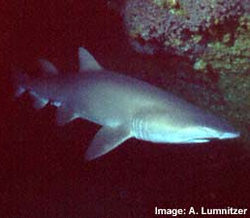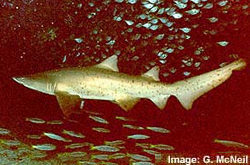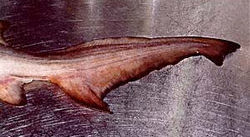|
|
|
 |
Grey Nurse Shark (Carcharias taurus Rafinesque) |  |
|
Fast Facts |
||||
 An adult Gray nurse |
Idetification The Grey Nurse Shark lives in shallow coastal waters from the surf zone down to 60m, although it has been recorded from water as deep as 190m. Structural, physiological and behavioural adaptations: The Grey Nurse is a distinctive shark which is usually grey-brown on top and a dirty white underneath. A distinctive character of this species is that both dorsal fins and the anal fin are of a similar size. It is a sluggish species which is not considered dangerous to people, although divers should never provoke it. |
|||
|
Heterocercal Tail: Teeth |
 The tail of the Grey Nurse Shark is heterocercal and has a characteristic subterminal notch. This is seen in the upper image on the right. |
|||
 This image shows the tail of the other odontaspid shark found in Australia, the Sand Tiger Shark or Herbsts Nurse Shark, Odontaspis ferox |
||||